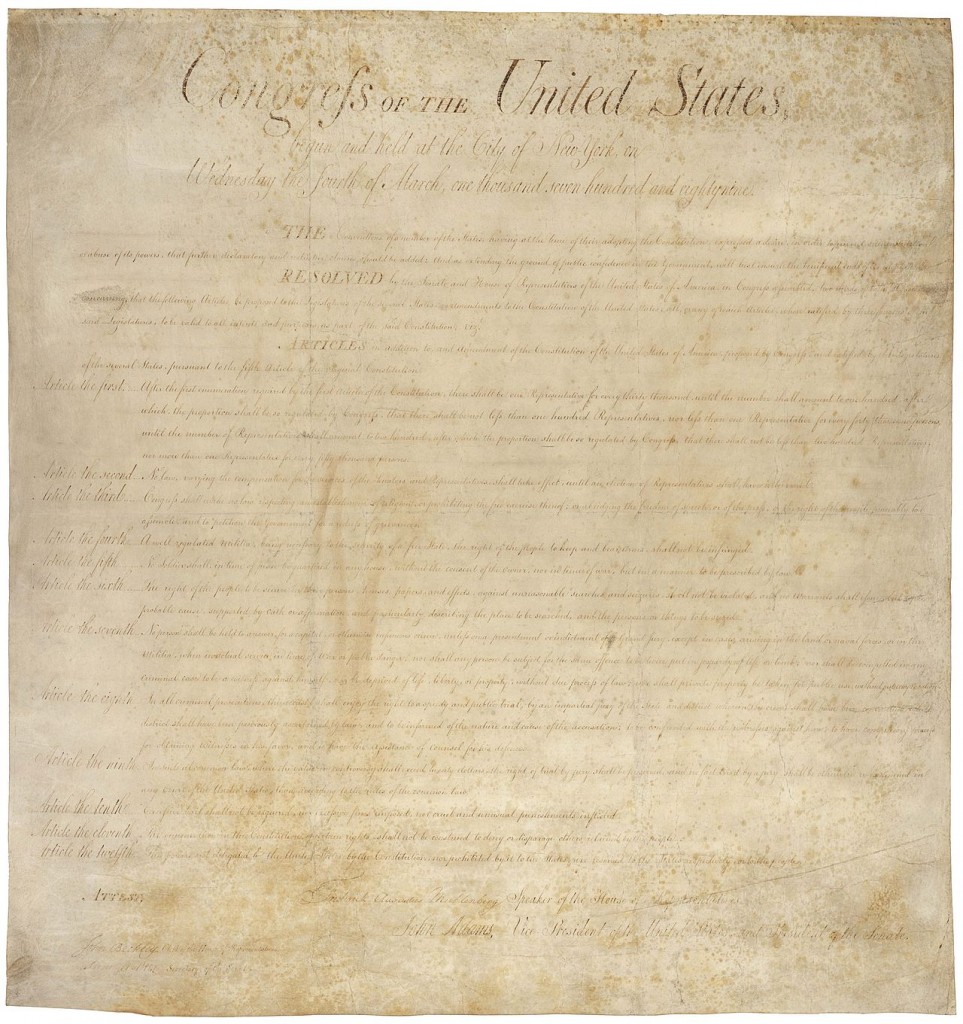Good morning, Whitewater.
Monday in town begins with fog, giving way to afternoon showers and a high of forty-seven. Sunrise is 7:19 AM and sunset 4:21 PM, for 9h 02m 45s of daytime. The moons is a waning crescent with 40.8% of its visible disk illuminated.
This is the time of year when meteor showers appearing in the sky near the constellation Gemini captivate skywatchers in both hemispheres. They Sydney observatory has photos of the event —
@ObservingSpace See this image taken from Australia by David Finlay #geminids #meteor pic.twitter.com/XjqTCfmrd2
— Sydney Observatory (@sydneyobs) December 15, 2014
On this day in 1791, after Virginia votes to ratify articles three to twelve of a proposed Bill of Rights, they become law as the first ten amendments to the United States Constitution:

The Bill of Rights, twelve articles of amendment to the to the United States Constitution proposed in 1789, ten of which, Articles three through twelve, became part of the United States Constitution in 1791. Note that the First Amendment is actually “Article the third” on the document, Second Amendment is “Article the fourth”, and so on. “Article the second” is now the 27th Amendment. “Article the first” has not been ratified. Via Wikipedia.
The Bill of Rights is the collective name for the first ten amendments to the United States Constitution. Proposed to assuage the fears of Anti-Federalists who had opposed Constitutional ratification, these amendments guarantee a number of personal freedoms, limit the government’s power in judicial and other proceedings, and reserve some powers to the states and the public. Originally the amendments applied only to the federal government, however, most were subsequently applied to the government of each state by way of the Fourteenth Amendment, through a process known as incorporation.
On June 8, 1789 Representative James Madison introduced a series of thirty-nine amendments to the constitution in the House of Representatives. Among his recommendations Madison proposed opening up the Constitution and inserting specific rights limiting the power of Congress in Article One, Section 9. Seven of these limitations would became part of the ten ratified Bill of Rights amendments. Ultimately, on September 25, 1789, Congress approved twelve articles of amendment to the Constitution and submitted them to the states for ratification. Contrary to Madison’s original proposal that the articles be incorporated into the main body of the Constitution, they were proposed as “supplemental” additions to it. On December 15, 1791, Articles Three–Twelve, having been ratified by the required number of states, became Amendments One–Ten of the Constitution.
On May 7, 1992, after an unprecedented period of 202 years, 225 days, Article Two crossed the Constitutional threshold for ratification and became the Twenty-seventh Amendment. As a result, Article One alone remains unratified and still pending before the states.
The Bill of Rights enumerates freedoms not explicitly indicated in the main body of the Constitution, such as freedom of religion, freedom of speech, a free press, and free assembly; the right to keep and bear arms; freedom from unreasonable search and seizure, security in personal effects, and freedom from warrants issued without probable cause; indictment by a grand jury for any capital or “infamous crime”; guarantee of a speedy, public trial with an impartial jury; and prohibition of double jeopardy. In addition, the Bill of Rights reserves for the people any rights not specifically mentioned in the Constitution and reserves all powers not specifically granted to the federal government to the people or the States. The Bill was influenced by George Mason’s 1776 Virginia Declaration of Rights, the English Bill of Rights 1689, and earlier English political documents such as Magna Carta (1215).
In our state’s history on this day in 1846, Wisconsinites reject a drafted state constitution:
1847 – Wisconsin’s Second Constitutional Convention Convenes in Madison
On this date the first draft of the Wisconsin Constitution was rejected in 1846. As a result, Wisconsin representatives met again to draft a new constitution in 1847. New delegates were invited, and only five delegates attended both conventions. The second convention used the failed 1846 constitution as a springboard for their own, but left out controversial issues such as banking and property rights for women that the first constitution attempted to address. The second constitution included a proposal to let the people of Wisconsin vote on a referendum designed to approve black suffrage. [Source: Attainment of Statehood by Milo M. Quaife]
Google-a-Day asks a question about a prominent political family:
At what school did the man who was the great grandson of one president and the grandson of another president become a history professor in the 1870s?
